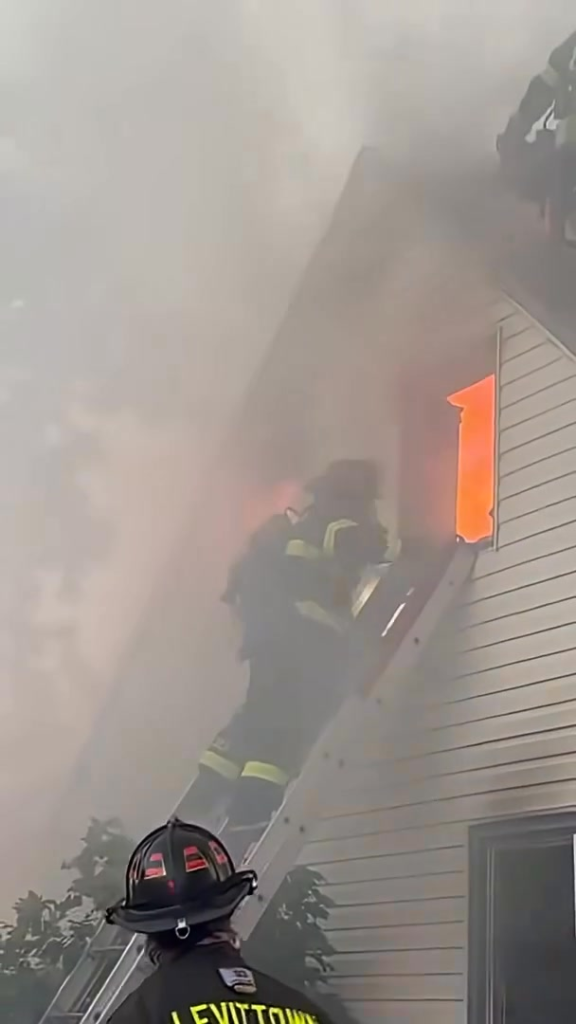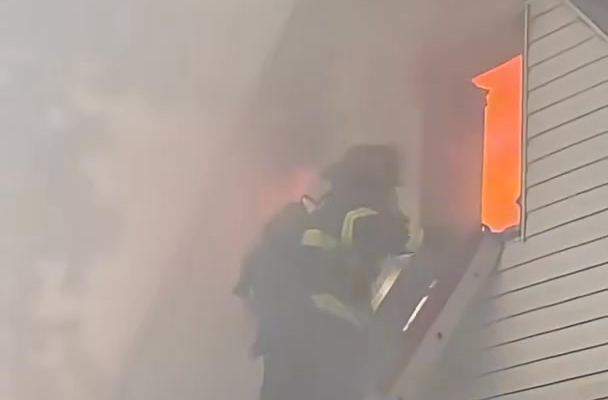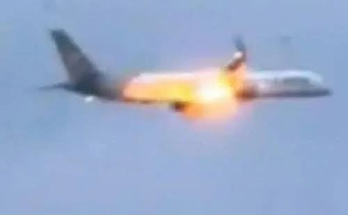In the profession of firefighting, no call is ever routine. A shift can begin with quiet hours of preparation and suddenly shift into a life-or-death battle with flames. Even the most experienced crews know that what starts as an ordinary house fire can escalate into chaos in seconds. That reality was made vividly clear when a team of firefighters recently found themselves inside a burning home that suddenly erupted in a flashover — a fire phenomenon so extreme that survival often comes down to sheer seconds.
Their narrow escape was not only a dramatic story but also a powerful reminder of the hazards firefighters willingly face, the importance of training, and the science behind one of the most dangerous stages of a structural fire.
The Call That Changed Everything
According to initial reports, emergency dispatch received a call in the early hours of the morning about heavy smoke pouring from a residential home. Neighbors feared that someone might still be inside. Firefighters rushed to the scene, knowing that the possibility of a trapped occupant could mean the difference between life and death.
When the crew arrived, smoke billowed from the roofline and windows. Neighbors anxiously pointed toward the house, adding urgency to the operation. Firefighters quickly donned their protective gear — turnout coats, helmets, gloves, and breathing apparatus — before making entry.
Inside, the environment was already deteriorating. Visibility dropped as thick black smoke descended toward the floor. Temperatures climbed rapidly, and conditions shifted from tense to critical in moments. Unknown to the firefighters, the home was about to experience one of the most feared events in fire dynamics: a flashover.
A Sudden Turn: The Flashover
As the team advanced deeper into the smoke-filled rooms, the heat intensified. Then, in an instant, the fire transitioned. Flames suddenly rolled across the ceiling. Superheated gases ignited almost simultaneously, turning the room into an inferno.
Recognizing the deadly change, the firefighters reacted instinctively. They dropped tools, turned toward exits, and bailed out through doors and windows. Onlookers outside captured the terrifying moments on video: firefighters leaping from openings, pursued by rolling smoke and fire. Their escape was measured not in minutes, but in heartbeats.
What Exactly Is a Flashover?
To understand the magnitude of this incident, it helps to know what a flashover entails. In fire science, a flashover is one of the most dangerous phenomena in structural fires.
- Definition: A flashover occurs when the temperature within a confined space rises so high that every combustible surface — furniture, flooring, clothing, and even the walls themselves — simultaneously ignite.
- Warning Signs: Heavy dark smoke lowering toward the floor, rolling fire gases along the ceiling, and a sudden, sharp rise in heat.
- Outcome: Survival inside becomes almost impossible. The only chance is immediate escape.
Temperatures during a flashover can exceed 1,000°F (540°C). No protective gear can withstand such heat for long. This is why firefighters emphasize constant awareness of escape routes, rapid decision-making, and recognition of early warning signs.
Why Flashovers Are So Deadly
For firefighters, most dangers are visible: flames, collapsing structures, or falling debris. Flashover is different because it is both sudden and overwhelming.
- Timeframe: Unlike a slow-burning fire, a flashover can happen in seconds.
- Heat Levels: Even state-of-the-art turnout gear offers only brief protection at extreme temperatures.
- Visibility: Dense black smoke obscures exits, making escape disorienting.
- Unpredictability: Even trained experts cannot always predict when a fire will reach the flashover stage.
Sadly, history has recorded numerous firefighter fatalities caused by flashovers. The fact that this crew managed to escape underscores the value of rigorous training and instinctive reactions.
The Human Side of the Story
Beyond the science lies the human element. Firefighters are not only battling flames but also the fear that someone may be trapped inside. Their mission is not just property protection but life preservation.
One firefighter later reflected:
“We go in because we hope to bring someone out. But when the fire flashes like that, you don’t get a second chance. We were fortunate to make it out alive.”
That perspective highlights the bravery required to enter a burning home at all. Every decision — whether to advance deeper or retreat — is made with both courage and calculated risk.
Was Anyone Inside?
Initial concerns suggested an occupant might still be in the home. This possibility drove the crew to attempt an aggressive interior search despite worsening conditions. After the bailout, additional teams regrouped and searched the structure once conditions stabilized. Fortunately, no residents were found inside.
While this brought relief, the home itself was a total loss. Yet, in many ways, the outcome was the best possible: no civilian casualties and a firefighter crew that lived to serve another day.
The Community Responds
Word of the incident spread quickly. Social media platforms filled with clips of the firefighters’ daring escape. Community members reacted with shock, gratitude, and relief.
- Some expressed disbelief at how close the team had come to disaster.
- Others praised the firefighters for their courage and dedication.
- Many residents stopped by the local firehouse with food, water, and thank-you notes.
This outpouring of support demonstrated a shared recognition: firefighters routinely risk their lives for others, often with little acknowledgment until an incident like this highlights their sacrifice.
The Science of Fire Behavior
To grasp why this event unfolded so quickly, it’s useful to examine fire development. Fire behavior experts describe structural fires in four main stages:
- Incipient Stage – The fire begins, usually localized to one object. Oxygen is plentiful, and flames are relatively small.
- Growth Stage – Flames spread to nearby surfaces, smoke thickens, and temperatures climb. Conditions become increasingly dangerous.
- Flashover Stage – Radiant heat reaches the ignition point of all combustibles. In an instant, the room erupts in flames.
- Fully Developed Stage – The fire consumes all available fuel until suppression or collapse occurs.
Recognizing the transition from growth to flashover is one of the most critical — and difficult — skills firefighters must master.
Training: The Key to Survival
The crew’s survival in this incident was no accident. It reflected countless hours of training and preparation. Modern firefighter education emphasizes not just suppression tactics but survival skills.
- Flashover Simulators: Training environments where firefighters can observe and react to flashover conditions in controlled settings.
- Bailout Drills: Practicing emergency window exits using ropes, ladders, or other rapid escape methods.
- Thermal Imaging: Using cameras to detect heat levels invisible to the naked eye.
- Air Management: Monitoring oxygen supply carefully during operations.
By repeating these drills, firefighters develop muscle memory that allows them to react instantly when real emergencies strike.
Equipment That Makes a Difference
Training is only part of the equation. Modern firefighting also relies heavily on advanced gear designed to protect lives.
- Turnout Gear: Made of heat- and flame-resistant materials such as Nomex and Kevlar.
- Self-Contained Breathing Apparatus (SCBA): Portable oxygen supplies allowing firefighters to breathe in smoke-filled environments.
- Thermal Imaging Cameras (TICs): Provide visibility through dense smoke by detecting heat signatures.
- PASS Devices: Motion alarms that alert rescuers if a firefighter becomes immobile.
Despite these innovations, flashovers remain essentially unsurvivable without escape. Technology can buy precious seconds, but only awareness and rapid action prevent tragedy.
The Psychological Impact
While the public often sees the physical heroics of firefighting, the emotional burden is less visible. Surviving a close call can weigh heavily on firefighters long after the flames are out.
Post-traumatic stress, anxiety, and survivor’s guilt are common after near-death experiences. Many departments now emphasize mental health just as much as physical readiness. Peer support groups, counseling, and wellness programs are increasingly available to help firefighters cope with trauma.
Recognizing that mental resilience is as important as physical safety ensures that crews remain capable of serving their communities effectively.
Why Modern Fires Are More Dangerous
Fire behavior has also changed in recent decades. Experts note that today’s residential fires often reach flashover faster than those of previous generations.
- Synthetic Materials: Modern furniture made of plastics and foams ignites faster and burns hotter than natural wood or cotton.
- Lightweight Construction: New building materials can fail structurally more quickly under fire.
- Open Floor Plans: Popular in modern homes, these designs allow fire to spread unchecked.
Decades ago, a house fire might take 15–20 minutes to reach flashover. Today, it can happen in as little as 4–6 minutes. This accelerates danger not just for firefighters but for residents as well.
Lessons for the Public
While the bravery of firefighters often takes center stage, there are important takeaways for everyday people too:
- Install and Maintain Smoke Alarms: Early detection provides critical escape time.
- Have an Escape Plan: Families should practice multiple exit routes and designate a meeting spot.
- Close Doors: Keeping interior doors shut can slow fire spread and delay flashover.
- Never Re-enter a Burning Building: Leave rescues to professionals. Once outside, stay outside.
Public awareness of fire dynamics can significantly improve survival rates in home fires.
Broader Significance
This close call illustrates the delicate balance firefighters maintain between risk and reward. Entering a burning building is always hazardous, yet they do so willingly when human life may be at stake.
The incident also emphasizes why continued investment in fire departments is essential. Proper staffing, modern equipment, and up-to-date training directly impact survival outcomes — both for the public and for the firefighters themselves.
Conclusion: Courage in the Face of Fire
The firefighters who survived the flashover did so because of their training, teamwork, and quick instincts. Their story will remain a vivid example of how unpredictable and dangerous fire can be.
While the home was lost, lives were preserved — a reminder that, ultimately, the greatest measure of success in firefighting is not the saving of property but the preservation of human life.
For the community, the event reinforced gratitude toward first responders. For firefighters, it was another lesson in humility before the power of fire and the importance of constant vigilance.
In the end, their survival is both a testament to human resilience and a powerful message: in the battle between fire and firefighter, preparation, courage, and seconds truly make the difference.




